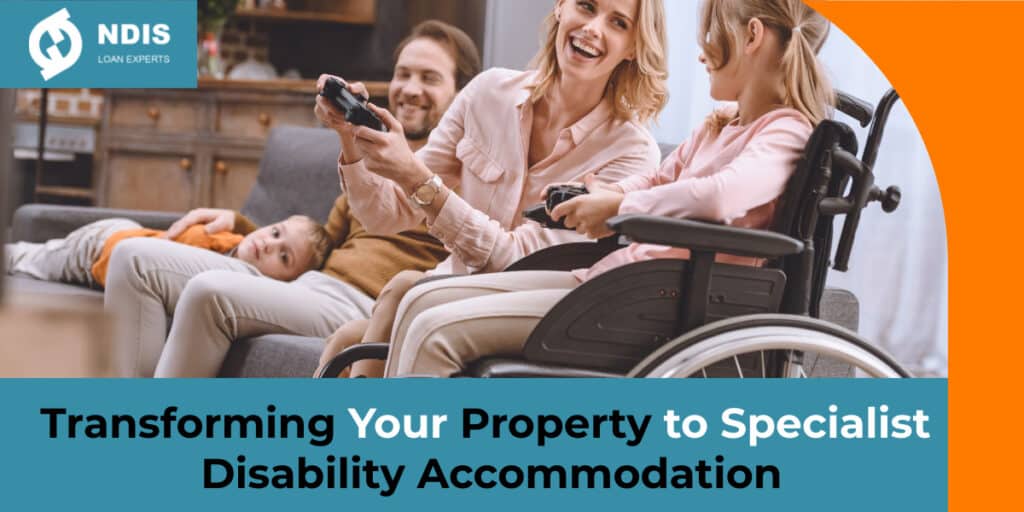If you want to upgrade an existing home to qualify as specialist disability accommodation (SDA), it’s important to be aware of the costs involved. Read on to find out everything you need to know.
What is specialist disability accommodation?
SDA is an accommodation that’s specifically designed to meet the needs of eligible National Disability Insurance Scheme (NDIS) participants who have the highest living support needs.
There are four main types of SDA:
1) improved liveability,
2) robust,
3) fully accessible,
4) high physical support.
Each type of SDA has its own specific minimum design standard requirements that you must meet or exceed. It’s possible for an SDA to meet more than one design standard requirement. If it does, this makes it more marketable to potential SDA tenants.
Options to convert existing properties to SDA
You must renovate an existing non-SDA property so that it’s classified as a ‘new build’ for the purposes of SDA. In addition to meeting at least one of the SDA design standard requirements, you must spend a minimum amount on the renovation.
The minimum amount varies based on the:
- type of SDA,
- size of the SDA (e.g. number of bedrooms),
- number of residents the SDA can house (e.g., single homes versus group homes that can house up to five residents),
- whether the SDA includes provisions for onsite overnight assistance (OOA).
Cost ranges for 2021-22 are outlined in the NDIS pricing arrangements and summarised in the tables below.
| Type of SDA accommodation | Minimum SDA renovation cost range |
| Improved liveability apartments | $206,902 (1 bedroom, 1 resident, no OOA) to $326,688 (3 bedrooms, 2 residents, no OOA) |
| Improved liveability villas, duplexes, townhouses | $119,786 (1 resident, no OOA)to$217,792 (3 residents plus OOA) |
| Improved liveability houses | $163,344 (2 residents, no OOA) to$250,461 (3 residents plus OOA) |
| Improved liveability group homes | $141,564 (4 residents, no OOA) to $359,356 (5 residents, OOA) |
| Robust apartments | N/A |
| Robust villas, duplexes, townhouses | $249,939 (1 resident, no OOA)to$442,794 (3 residents plus OOA) |
| Robust houses | $338,614 (2 residents, no OOA) to$495,925 (3 residents plus OOA) |
| Robust group homes | $615,960 (4 residents, no OOA) to $705,710 (5 residents, OOA) |
| Fully accessible apartments | $363,142 (1 bedroom, 1 resident, no OOA) to $586,493 (3 bedrooms, 2 residents, no OOA) |
| Fully accessible villas, duplexes, townhouses | $211,548 (1 resident, no OOA)to$368,760 (3 residents plus OOA) |
| Fully accessible houses | $281,410 (2 residents, no OOA) to$417,791 (3 residents plus OOA) |
| Fully accessible group homes | $524,679 (4 residents, no OOA) to $601,511 (5 residents, OOA) |
| High physical support apartments | $363,142 (1 bedroom, 1 resident, no OOA) to $586,493 (3 bedrooms, 2 residents, no OOA) |
| High physical support villas, duplexes, townhouses | $283,130 (1 resident, no OOA)to$511,812 (3 residents plus OOA) |
| High physical support houses | $381,136 (2 residents, no OOA) to$609,816 (3 residents plus OOA) |
| High physical support group homes | $740,492 (4 residents, no OOA) to $860,277 (5 residents, OOA) |
What is the difference between SDA and SIL?
SDA refers to accommodation, SIL (supported independent living) refers to the type of support an NDIS recipient may receive. SDA recipients may receive SIL in the form of paid support workers visiting their home, but not all SIL recipients will be in SDA.
Is SDA a good investment?
Transforming a property to be compliant with SDA requirements can involve significant costs. It’s important to do a thorough cost-benefit analysis to make sure it’s worthwhile. It’s crucial that you transform a property in a location where there is also high demand.
If you’d like to learn more about investing in NDIS property, please contact us today.


